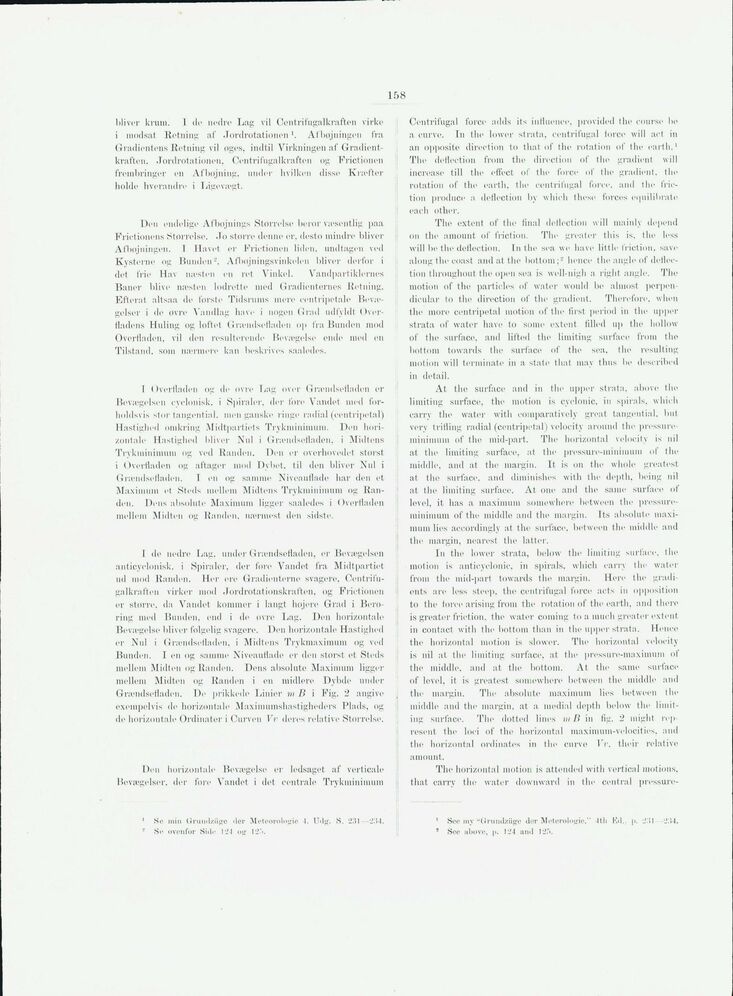
Full resolution (JPEG) - On this page / på denna sida - Sidor ...

<< prev. page << föreg. sida << >> nästa sida >> next page >>
Below is the raw OCR text
from the above scanned image.
Do you see an error? Proofread the page now!
Här nedan syns maskintolkade texten från faksimilbilden ovan.
Ser du något fel? Korrekturläs sidan nu!
This page has never been proofread. / Denna sida har aldrig korrekturlästs.
bliver krum. I de nedre Lag vil Centrifugalkraften virke
i modsat Retning af JordrotationenAfbøjningen fra
Gradientens Retning vil øges. indtil Virkningen af
Gradientkraften. Jordrotationen. Centrifugalkraften og Frictionen
frembringer en Afbøjning, under hvilken disse Kno ft er
holde hverandre i Ligevægt.
Den endelige Afbøjnings Størrelse beror va’sentlig paa
Frietionens Størrelse. .Io større denne er. desto mindre bliver
Afbøjningen. I Havet er Frictionen liden, undtagen ved
Kysterne og Bunden-. Afbøjningsvinkelen bliver derfor i
det frie Hav næsten en ret Vinkel. Vandpartiklernes
Baner blive næsten lodrette med Gradienternes Retning.
Efterat altsaa de første Tidsrums mere centripetale
Bevægelser i de øvre Vandlag have i nogen Grad udlyldt
Overfladens Huling og løftet Grændsofliiden op fra Bunden mod
Overfladen, vil den resulterende Bevægelse ende med en
Tilstand, som nærmere kan beskrives saaledes.
I Overfladen og de ovre Lag over Gramdsefiaden er
Bevægelsen cyelonisk. i Spiraler, der fore Vandet med
forholdsvis stor tangential, men ganske ringe radial (centripetal)
Hastighed omkring Midtpartiets Trykniinimuni. Den
horisontale Hastighed bliver Nnl i Gramdsefladen. i Midtens
Trykininimuni og ved Randen. Den er overhovedet størst
i Overfladen og aftager mod Dybet, til den bliver Nul i
Grændsofladen. I en og samme Niveauflade har den et
Maximum et Steds mellem Midtens Trykniiniinum og
Randen. Dens absolute Maximum ligger saaledes i Overfladen
mellem Midten og Randen, nærmest den sidste.
1 de nedre Lag, under Gramdsefladen, er Bevægelsen
anticyclonisk. i Spiraler, der føre Vandet fra Midtpartiet
ud mod Randen. Her ere Gradienterne svagere,
Centrifugalkraften virker mod Jordrotationskraften, og Frictionen
er større, da Vandet kommer i langt højere Grad i
Berøring med Blinden, end i de øvre Lag. Den horisontale
Bevægelse bliver følgelig svagere. Den hori/.ontale Hastighed
er Nid i Gramdsefladen. i Midtens Trykmaximum og ved
Blinden. I en og samme Niveauflade er den størst et Steds
mellem Midten og Randen. Dens absolute Maximum ligger
mellem Midten og Randen i en midlere Dybde under
Grændsofladen. De prikkede Linier vi B i Fig. 2 angive
exempelvis de horizøntale Maximumshastigheders Plads, og
do horizøntale Ordinater i Curven l’Y deres relative Størrelse.
Den horizøntale Bevægelse er ledsaget af verticale
Bevægelser, der føre Vandet i dot centrale Trykminimum
158
Centrifugal force adds its influence, provided the course be
a curve. In the lower strata, centrifugal force will act in
an opposite direction to that of the rotation ol’ the earth.1
The deflection from the direction of the gradient will
increase till the effect of the force ol’ the gradient, the
rotation of the earth, the centrifugal force, and the
friction produce a deflection by which those forces equilibrate
each other.
The extent of the final deflection will mainly depend
on the amount of friction. The greater this is. the less
will be the deflection. In the sea we have little friction, save
along the coast and at the bottom;2 hence the angle of
deflection throughout the open sea is well-nigh a right angle. The
motion of the particles of water would be almost
perpendicular to the direction of the gradient. Therefore, when
the more centripetal motion of the first period in the upper
strata of water have to some extent filled up the hollow
of the surface, and lifted the limiting surface from the
bottom towards the surface of the sea, tin* resulting
motion will terminate in a state that may thus be described
in detail.
At the surface and in the upper strata, above tin*
limiting surface, the motion is cyclonic, in spirals, which
carry the water with comparatively great tangential, but
very trifling radial (centripetal) velocity around the
pressure-minimum of the mid-part. The horizontal velocity is nil
at the limiting surface, at the pressure-minimum of the
middle, and at the margin. It is on the whole greatest
at the surface, and diminishes with the depth, being nil
at the limiting surface. At one and the same surface of
level, it has a maximum somewhere between the
pressuro-miniinum of the middle and the margin. Its absolute
maximum lies accordingly at the surface, between the middle and
the margin, nearest the latter.
In the lower strata, below the limiting surface, Ille
motion is anticyclonic, in spirals, which carry the water
from the mid-part towards the margin. Here the
gradients are loss steep, the centrifugal force acts in opposition
to the force arising from the rotation of the earth, and there
is greater friction, the water coming to a much greater extent
in contact with the bottom than in the upper strata. Hence
the horizontal motion is slower. The horizontal velocity
is nil at the limiting surface, at the pressure-maximum of
the middle, and at the bottom. At the same surface
of level, it is greatest somewhere between the middle and
the margin. The absolute maximum lies between the
middle and the margin, at a medial depth below the
limiting surface. The dotted linos vi B in fig. 2 might
represent the loci of the horizontal maximum-velocities, and
the horizontal ordinat.es in the curve Vr. their relative
amount.
The horizontal motion is attended with vertical motions,
that carry the water downward in the central prossure-
i min üruiulzüge ’ler Meteorologie -I. Udg. S. 231—2:54. 1 See my "örundzüge der Meterolo»ic." Itli Rd.. |>. 231 -234.
• ovenfor Side 124 og 12.">. 5 See above, i>. 124 anil 125.
<< prev. page << föreg. sida << >> nästa sida >> next page >>